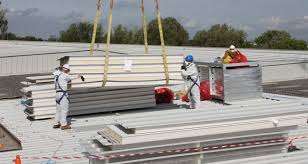Risk Revealed: The Imperative of Regular Asbestos Inspections

Introduction
Asbestos, a naturally occurring mineral, was once hailed for its versatility and used prolifically in various industries. However, its hazardous impact on health has since overshadowed its utility. xs,kThis article delves into the critical need for regular asbestos inspections, highlighting the expertise of organizations like Supernova Asbestos Surveys in safeguarding public health and ensuring compliance with legal requirements.
The History and Prevalence of Asbestos Use
Industrial and Residential Applications
Asbestos found widespread use in both industrial and residential settings, primarily due to its fire resistance, durability, and insulating properties. It was commonly used in construction materials, automotive parts, and even household products, making its presence ubiquitous in structures built before the late 20th century.
Global Regulations and Bans
The discovery of asbestos-related health risks led to stringent regulations and eventual bans in several countries.
These regulations not only restricted the use of asbestos but also mandated the management of existing asbestos-containing materials, especially in older buildings.
Health Risks Associated with Asbestos Exposure
Short-term and Long-term Health Effects
Exposure to asbestos fibers can lead to serious health conditions, including asbestosis, lung cancer, and mesothelioma. These diseases often manifest years after exposure, making early detection and prevention crucial. Short-term exposure might not result in immediate symptoms, yet it contributes to cumulative health risks over time.
Case Studies: Impact on Public Health
Various case studies have demonstrated the severe impact of asbestos on public health. Instances of widespread asbestos-related diseases in communities, particularly those near industrial sites, have been well-documented, providing a stark reminder of the material’s hazardous nature.
The Need for Regular Asbestos Inspections
Identifying Potential Asbestos Contamination
Regular asbestos inspections are vital in identifying potential contamination, especially in older buildings. These inspections help in assessing the condition of asbestos-containing materials and determining whether they pose a risk to occupants.
Legal Requirements and Safety Standards
Beyond health considerations, there are legal implications and safety standards that mandate regular asbestos inspections. Compliance with these regulations is essential for property owners to avoid legal liabilities and ensure the safety of building occupants.
Conducting Effective Asbestos Inspections
The Process of Asbestos Surveys
Asbestos surveys are a systematic process involving the inspection of premises for the presence of asbestos-containing materials. This process includes sampling, laboratory analysis, and risk assessment, culminating in a detailed report that guides the management or removal of asbestos.
Selecting a Qualified Asbestos Inspector
Choosing the right professional for an asbestos survey is critical. A qualified inspector from a reputable company like Supernova Asbestos Surveys ensures thoroughness, compliance with regulations, and accurate risk assessment.
Deeper Analysis of Asbestos-Related Health Risks
Further in-depth analysis reveals that asbestos-related health risks extend beyond the commonly known diseases. Research has shown that environmental exposure, often overlooked, can be just as harmful as occupational exposure. Studies in communities situated near natural asbestos deposits have indicated elevated incidences of mesothelioma, underscoring the need for comprehensive asbestos management strategies that encompass environmental factors as well.
Additional Examples of Global Asbestos Challenges
Globally, the challenge of asbestos management varies significantly. In developing countries, the use of asbestos is often unregulated, leading to increased health risks. For example, in some Asian countries, the rapid industrialization and lax regulations have resulted in a surge of asbestos-related health issues. These scenarios highlight the need for international cooperation and support in implementing effective asbestos management policies and practices.
Expanding the Scope of Regular Inspections
Expanding the scope of regular asbestos inspections to include environmental assessments and community education programs can significantly mitigate the risks. Such comprehensive approaches are crucial, especially in areas where the historical use of asbestos has been extensive. By integrating these broader strategies, authorities and organizations like Supernova Asbestos Surveys can play a pivotal role in safeguarding public health and ensuring a future free from asbestos-related risks.
Case Studies: The Consequences of Neglecting Asbestos Inspections
Residential and Industrial Examples
The article would present case studies illustrating the consequences of neglecting asbestos inspections in both residential and industrial settings. These examples highlight the potential risks to health and safety, as well as the legal and financial repercussions of non-compliance.
Lessons Learned and Best Practices
These case studies also offer valuable lessons and best practices in asbestos management, emphasizing the importance of regular inspections and proactive measures.
Future Trends and Innovations in Asbestos Management
Technological Advancements
Emerging technologies in the field of asbestos detection and removal promise to enhance the effectiveness and efficiency of managing asbestos risks. Innovations like advanced imaging techniques and AI-driven analysis are set to revolutionize asbestos surveys and management.
Changing Legal Landscapes
The evolving legal landscape around asbestos management, including stricter regulations and heightened awareness, necessitates staying abreast of changes to ensure compliance and optimal safety standards.
Conclusion
In conclusion, the article reaffirms the critical importance of regular asbestos inspections, underlining the role of experts like Supernova Asbestos Surveys in maintaining public safety and legal compliance. It calls for proactive management and awareness to mitigate the risks associated with asbestos, ensuring a safer environment for current and future generations.





